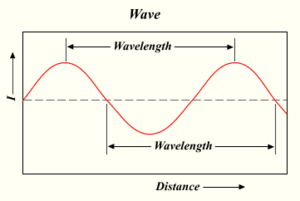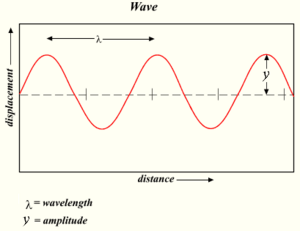Sine wave facts for kids
A sine wave is a special kind of curve that looks like a smooth, repeating wave. Imagine a rope you shake up and down; the shape it makes is similar to a sine wave.
Sine waves have a pattern that repeats over and over. The length of one full repeating part of the wave is called its wavelength. You can find the wavelength by measuring the distance from one peak (the highest point) of the wave to the next peak.
Contents
What Are Sine Waves?
Sine waves are super important because almost all other waves can be made by adding many sine waves together. This means that even complex waves are just combinations of these simple, repeating shapes.
Where Do We See Waves?
Waves are all around us in the natural world. Here are some common examples:
- sound waves, which let us hear
- light waves, which let us see
- water waves, like those in an ocean or lake
- earthquake waves, which travel through the ground
All these waves are actually made up of many different sine waves combined.
Key Features of Sine Waves
Besides their wavelength, sine waves have other important features. These include their frequency, amplitude, phase, and speed. Understanding these helps us describe how different waves behave.
Understanding Frequency and Period
Sine waves are called "periodic" because they repeat over time. The period of a sine wave is the time it takes for one complete cycle of the wave to pass. We often use the letter T to represent the period.
The frequency of a sine wave tells us how many full cycles happen in just one second. Frequency is measured in Hertz (Hz). One Hertz means one cycle per second. You can find the frequency by dividing 1 by the period (1/T).
Images for kids
See also
 In Spanish: Sinusoide para niños
In Spanish: Sinusoide para niños





